A root cellar lets you naturally preserve vegetables through winter using Earth's consistent underground temperatures and humidity. You'll want to dig at least 6 feet deep in a shaded area, ideally on a hillside, to maintain ideal conditions of 32-40°F and 85-95% humidity. Build your cellar with natural materials like wood and stone, adding gravel floors for drainage and proper ventilation systems to prevent mold. Store different vegetables separately according to their specific needs, using materials like sand or sawdust for insulation. By following proper construction and maintenance guidelines, you'll discover how to keep your harvest fresh for months without electricity.
Understanding Root Cellar Basics

Delving into root cellar basics reveals a carefully balanced system of four essential elements: temperature, humidity, ventilation, and construction.
You'll need to maintain temperatures between 32-40°F (0-4°C) for ideal storage, though you can still preserve some vegetables at slightly higher temperatures up to 50°F.
Your root cellar's humidity should stay between 85-95% to prevent your vegetables from drying out. You'll achieve this naturally with a dirt floor, and you can enhance moisture levels by adding gravel on packed earth. If you need to increase humidity, simply sprinkle water on the gravel. Regular monitoring with hygrometers and thermometers helps maintain optimal conditions.
Proper ventilation is vital – you'll want to prevent ethylene gas buildup while maintaining consistent air circulation. Install an airlock or double doors, and include windows or exhaust pipes that you can adjust.
Don't forget to leave a 2-inch gap between shelves and walls for air flow.
For construction, you've got options ranging from traditional materials like brick and concrete to alternative methods like earthbag construction.
Whatever you choose, make sure you've got proper footers to prevent wall shifting, and consider using the earth's natural insulation by building into a hillside.
Selecting Your Ideal Location
Before breaking ground on your root cellar, selecting the perfect location will make or break your food preservation success. You'll want to choose a spot that's both convenient and naturally suited for food preservation. Look for a shaded area away from direct sunlight, ideally on a hillside where you can dig at least 6 feet deep to access naturally cool temperatures below the frost line. A well-designed root cellar needs proper ventilation systems to maintain optimal storage conditions.
| Consideration | Key Requirements |
|---|---|
| Accessibility | Close to garden, easy path for transport |
| Temperature | Cool, stable, below frost line |
| Moisture | Good drainage, 85-95% humidity |
Your chosen location should allow for easy transport of produce from your garden while protecting against flooding and excess moisture. When selecting your spot, verify it enables frequent monitoring and maintenance of stored vegetables. The site should maintain autumn-like conditions year-round: cold, dark, and consistently damp without being waterlogged.
Remember to take into account the structural aspects of your chosen location. You'll need level ground or a hillside that can accommodate proper excavation, and the soil should allow for adequate drainage while supporting necessary insulation installations.
Planning The Storage Space
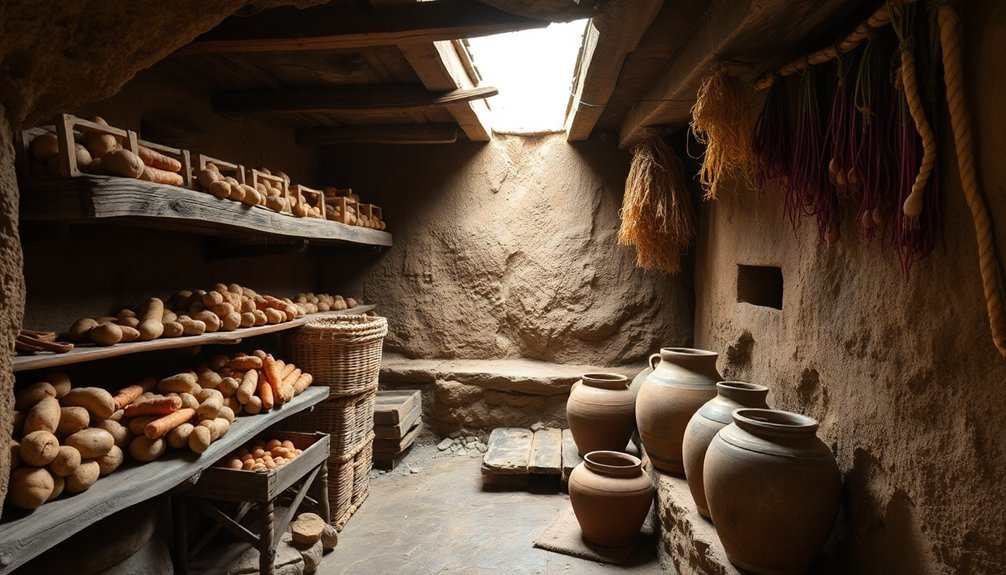
A well-planned root cellar maximizes every square foot while maintaining ideal storage conditions for your harvest. For most families, an 8-by-8 foot space offers ample storage, though you can opt for a smaller 4-by-6 foot cellar if you're working with limited space. A 6-foot ceiling height is typically sufficient. Small, full cellars are more effective at maintaining proper humidity levels.
Design your shelving system with efficiency in mind. Install shelves no deeper than 16 inches, and maintain an essential 2-inch gap between the wall and shelves for proper air circulation. You'll want to add a 1-to-2-inch cleat at the back of each shelf to keep stored items from touching the walls.
When planning storage zones, consider your vegetables' specific needs. Create separate areas for root vegetables in sand-filled boxes, leafy greens in high-humidity sections, and dry storage for onions and garlic.
Don't forget practical features like basic lighting and easy-to-clean surfaces. If you're installing the cellar inside your home, include a vapor barrier to protect against moisture. Choose rot-resistant wood for your shelving and consider using earthbags for an economical construction option.
Include gravel or dirt flooring to help manage humidity and drainage.
Temperature and Humidity Control
You'll need to maintain your root cellar's temperature between 32-40°F (0-4°C) and humidity levels at 85-95% to keep your vegetables fresh throughout winter.
Monitoring these conditions with thermometers and hygrometers lets you make quick adjustments through ventilation control and moisture management techniques like sprinkling water on the floor or using damp burlap bags.
Don't forget to check regularly for spoiled produce and guarantee proper air circulation, as these factors directly impact your storage environment's stability.
Maintaining Optimal Cold Conditions
Maintaining proper cold conditions in your root cellar requires careful attention to both temperature and ventilation. You'll need to keep the temperature between 32-40°F (0-4°C) to prevent freezing damage and avoid premature sprouting or decay.
Since warm air rises, you'll find higher temperatures at the top of your cellar, so it's crucial to monitor different levels using strategically placed thermometers.
To maintain best temperatures, verify your cellar has proper insulation on walls and ceilings. If you've dug your cellar into the ground, you'll benefit from natural earth insulation, as soil's poor heat conductivity helps maintain steady temperatures about 6 feet underground.
You'll also need effective ventilation with low air intake and high outlet points, ideally on opposite sides of the room.
Don't forget to elevate your storage crates to allow air circulation underneath. Installing an anteroom or double doors can help regulate temperature fluctuations when entering and exiting.
Check regularly for signs of spoilage and remove affected items promptly. If you notice temperature variations, adjust your ventilation and insulation accordingly to maintain ideal storage conditions.
Humidity Balance and Monitoring
Keeping your root cellar's humidity in check goes hand-in-hand with temperature control for successful vegetable storage. You'll want to maintain humidity levels between 90-95% to prevent your vegetables from drying out and shriveling. Use a hygrometer to monitor these levels regularly, making adjustments as needed throughout the storage season.
If you're working with a basement root cellar, you might need to add moisture by sprinkling water on the floor or hanging damp burlap bags. A dirt floor naturally helps maintain moisture, and you can add gravel on packed earth to keep the ground damp but not wet.
For root vegetables like carrots and beets, try packing them in damp sawdust, sand, or moss to maintain proper humidity.
Watch out for excess moisture, which can lead to mold and rot. Install proper ventilation using vents or fans to regulate airflow and remove vegetable odors and ethylene gas.
If humidity gets too high, improve air circulation; if it's too low, add trays of water or damp sand. Remember, a fuller root cellar naturally maintains higher humidity since vegetables are about 90% water.
Essential Ventilation Systems
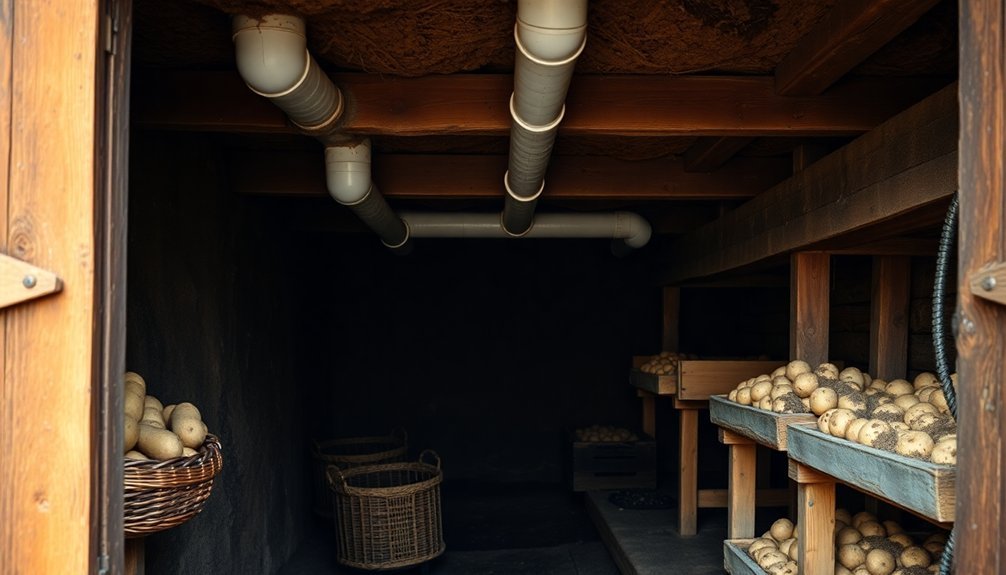
Your root cellar needs constant air movement to prevent moisture buildup and maintain ideal storage conditions for your vegetables.
You'll want both low intake vents to draw in cool air and high exhaust vents to let warm air escape, creating a natural convection current that keeps the environment fresh.
While natural airflow often works well, you can boost ventilation effectiveness by adding a small fan during periods of high humidity or when natural circulation isn't sufficient.
Air Flow Basics Required
Through proper ventilation, a root cellar's success largely depends on consistent airflow that regulates both temperature and humidity.
You'll need to understand the basic principles of air movement: cold air naturally sinks while warm air rises. By positioning intake vents low to the ground and outlet vents near the ceiling, you're creating an efficient convection system that maintains ideal storage conditions.
- Feel the satisfaction of watching your fresh harvest stay crisp and flavorful month after month
- Experience the pride of maintaining a sustainable food storage system that your ancestors relied on
- Enjoy the peace of mind knowing you're preserving food without using electricity
- Savor the connection to traditional preservation methods that have stood the test of time
- Delight in opening your root cellar to find perfectly stored vegetables, even in mid-winter
You can enhance this natural airflow by installing a fan, but only use it when outside temperatures are lower than inside.
Monitor your cellar's temperature with thermometers, aiming to maintain 32-40°F for most vegetables.
Remember to seal your vents properly using materials like expanding foam or rubber gaskets, and cap them during winter months to control airflow precisely.
Natural Vs Mechanical Systems
When designing a root cellar ventilation system, you'll need to choose between natural airflow methods and mechanical solutions, each offering distinct advantages for food preservation.
Natural systems rely on a two-vent setup, where cool air enters through a low vent while warm air exits through a higher one. You can implement this either vertically through the roof or horizontally across opposing walls.
Mechanical systems offer more control through earth tubes and turbine vents, allowing you to regulate temperature and humidity more precisely. These systems can include fans and larger pipe configurations to enhance airflow when natural ventilation isn't sufficient.
If you're prioritizing energy efficiency and lower costs, natural ventilation might be your best choice. You won't need electricity, and maintenance requirements are minimal.
However, if you're in an area with challenging climate conditions or need consistent airflow, mechanical systems provide better reliability. They're particularly effective at preventing mold and moisture issues through continuous air movement.
Consider combining both approaches for ideal results. You can use natural ventilation as your primary system and incorporate mechanical components as backup during periods of high humidity or temperature fluctuations.
Proper Storage Methods
Proper storage methods in a root cellar depend heavily on maintaining ideal environmental conditions and following specific organizational practices.
You'll need to keep temperatures between 32-40°F and humidity levels at 80-90% while ensuring complete darkness. To achieve this, use thermometers throughout your space and implement proper ventilation with mesh-covered vents.
Don't place containers directly on the floor – instead, use straw, sand, or sawdust as a buffer. These materials help maintain consistent moisture levels and prevent your vegetables from shriveling.
Weekly inspections are essential to catch any spoilage before it spreads to other produce.
- Your precious harvest deserves protection from temperature fluctuations that could destroy months of gardening work
- Each vegetable you've carefully grown needs the ideal environment to last through winter
- Your family's food security depends on proper storage techniques
- Fresh, home-grown produce brings unmatched satisfaction during cold months
- You're continuing a time-honored tradition of natural food preservation
Consider creating an ante-chamber for better temperature control, and use insulation on walls and ceilings to maintain prime conditions.
If needed, employ a heat source like a 100-watt light bulb during extremely cold periods to keep temperatures stable.
Vegetable-Specific Storage Requirements
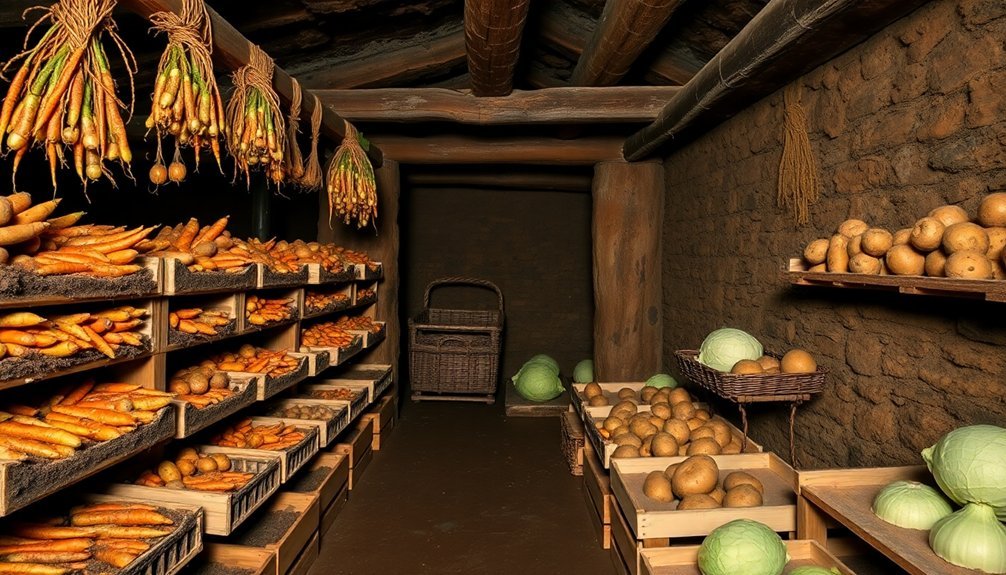
Different vegetables demand unique storage conditions to maintain their freshness throughout winter.
When storing root vegetables like carrots, beets, and parsnips, you'll need to maintain temperatures between 32-40°F (0-4°C) and high humidity levels of 85-95%. Layer these vegetables in sand, damp sawdust, or straw, and guarantee they're clean and dry before storage.
Leafy vegetables require similar temperature conditions but need consistent moisture levels to prevent wilting. You can store cabbage and kale with their roots attached, using slatted shelves for proper air circulation. Remove any damaged outer leaves and check regularly for signs of decay.
If you're planning long-term storage, consider replanting them in soil within your root cellar.
For bulb vegetables like onions and garlic, you'll want to focus on proper curing before storage. These vegetables prefer drier conditions, though they need the same cool temperatures. Store them in mesh bags or slatted crates to guarantee good airflow.
Don't mix different vegetable types in the same container, as they can affect each other's storage life and quality.
Monitoring and Maintenance Practices
Successfully storing vegetables through winter requires consistent monitoring and active maintenance of your root cellar's environment.
You'll need to check temperatures daily, aiming for 32-40°F (0-4°C), and maintain humidity levels between 85-95%. Install thermometers at different heights since warm air rises, and use hygrometers to track moisture levels throughout your storage space.
Regular inspection is essential for preventing produce loss. You'll want to remove any spoiled items immediately to protect your healthy vegetables.
Keep the space dark and well-ventilated to prevent ethylene gas buildup, using fans if needed. For additional cooling in warmer months, you can create ice blocks during winter to maintain ideal temperatures naturally.
Here's why proper monitoring matters:
- You'll save hundreds of dollars by preventing produce waste
- You'll protect your family's food security through winter
- You'll maintain the nutritional value of your stored vegetables
- You'll reduce your reliance on grocery stores during harsh weather
- You'll preserve the flavors of your garden-fresh produce longer
Clean and sanitize your cellar regularly, organize vegetables for proper airflow, and adjust ventilation as needed to maintain optimal storage conditions.
Natural Humidity Management
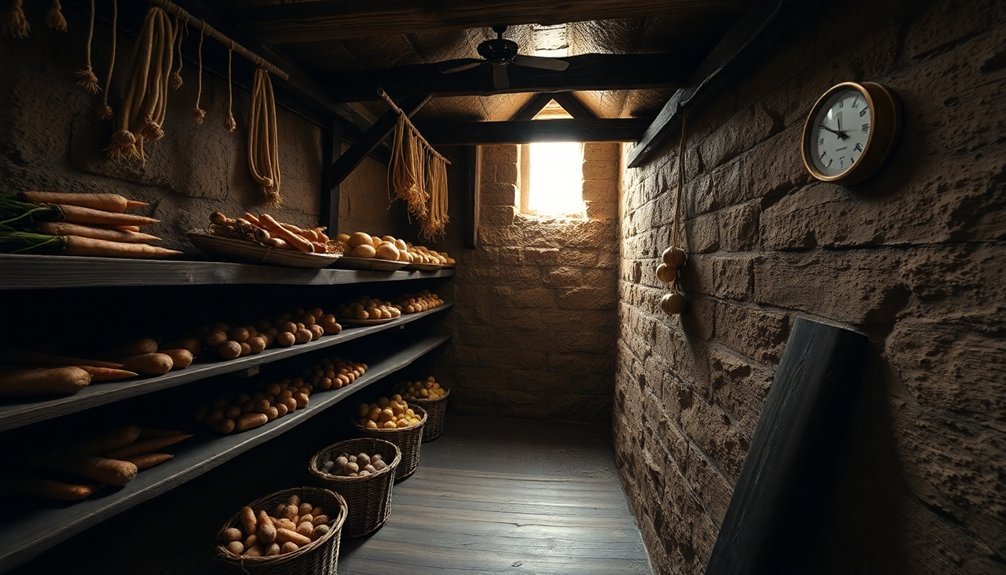
Droplets of moisture in your root cellar can make the difference between crisp vegetables and spoiled produce. You'll want to maintain humidity levels between 90-95% for ideal storage conditions. A dirt floor naturally helps achieve this, especially when topped with gravel to keep your feet dry while preserving moisture underneath.
You can boost humidity naturally by sprinkling water on the floor or using damp burlap bags. For individual vegetable storage, pack your root crops in moist sawdust, sand, or moss. This method works particularly well for carrots, beets, and parsnips, keeping them firm and fresh throughout the winter.
If you're dealing with excess moisture, you'll need to take action to prevent spoilage. Improve ventilation by adjusting your air intake and exhaust vents, or use desiccants to absorb extra moisture.
In spring, you might need a dehumidifier to manage rising humidity levels. To prevent unwanted moisture infiltration, waterproof your interior walls with DryLok, install proper rain gutters, and maintain good drainage around the cellar.
You can also place plastic sheeting over the gravel floor to control moisture seepage from below.
Frequently Asked Questions
Can I Store Fruits and Vegetables Together in the Same Root Cellar?
You shouldn't store fruits and vegetables together, as fruits release ethylene gas that can spoil vegetables. Keep them in separate sections to prevent cross-contamination, and guarantee proper ventilation between storage areas.
How Do I Protect Stored Vegetables From Mice and Other Pests?
You'll need to seal all entry points, use airtight containers, keep the space clean, and employ natural repellents like peppermint oil. Place food on elevated shelves and set up humane traps near potential entrances.
What Materials Are Best for Shelving and Storage Containers?
You'll want white oak lumber for shelving since it resists rot and provides strength. For storage containers, use 3/4-inch plywood to build boxes. Don't use pine or cottonwood as they'll deteriorate in humidity.
Should I Wash Vegetables Before Storing Them in the Root Cellar?
Don't wash your vegetables before storage. Instead, gently brush off excess soil, as washing can damage protective skins and introduce moisture. If you must wash, make certain they're completely dry before storing to prevent rot.
Can I Use My Root Cellar During Summer Months for Food Storage?
Yes, you can use your cellar during summer months if you maintain proper temperatures. You'll need good insulation, ventilation, and possibly ice blocks to keep temperatures between 32-40°F for ideal food storage.
In Summary
You'll find that a root cellar offers one of the most sustainable and cost-effective ways to store your harvest throughout winter. By following proper temperature, humidity, and ventilation guidelines, you're ensuring your vegetables stay fresh naturally. Whether you've built a simple underground storage space or a more elaborate cellar, you're preserving food the same way your ancestors did – without electricity or modern technology.

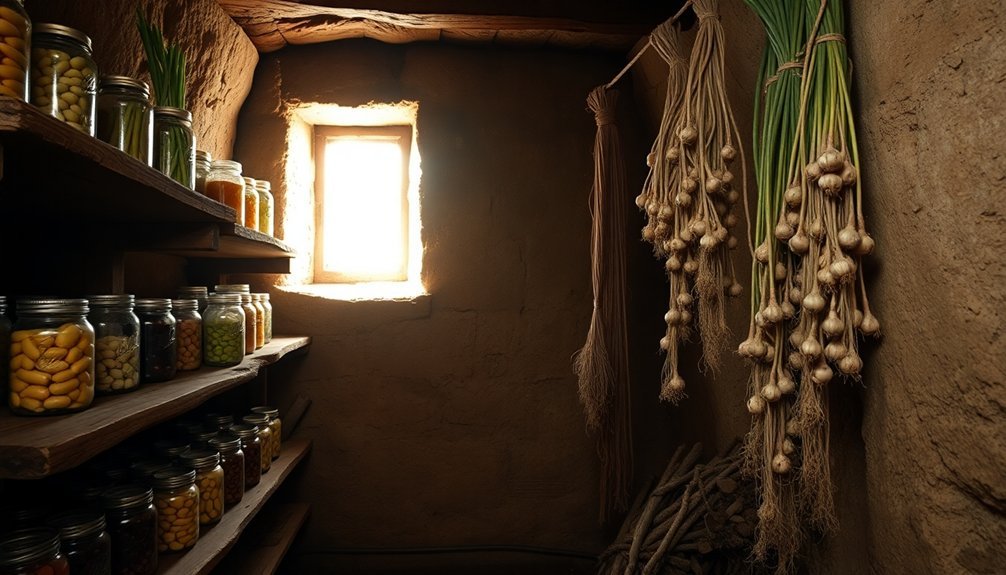
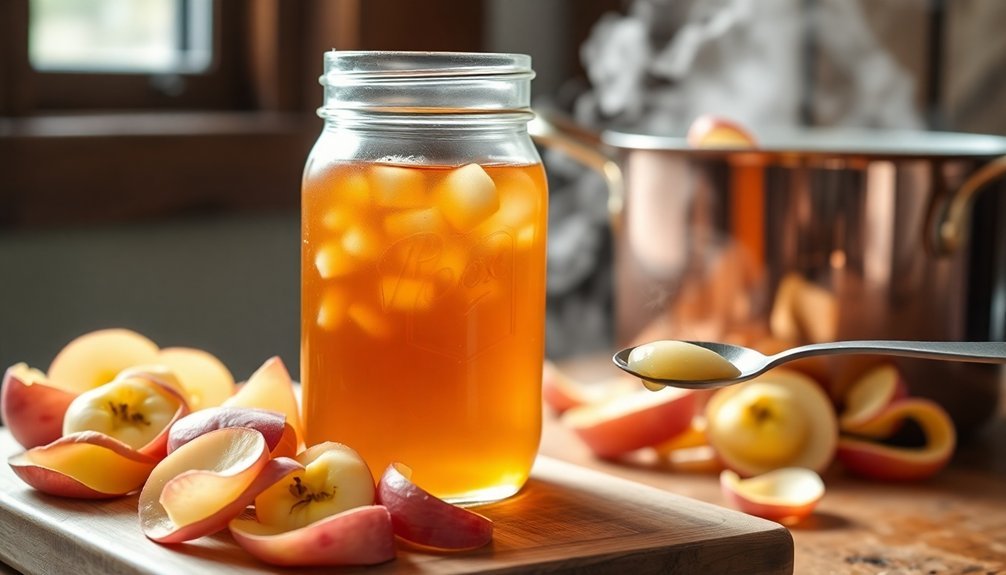
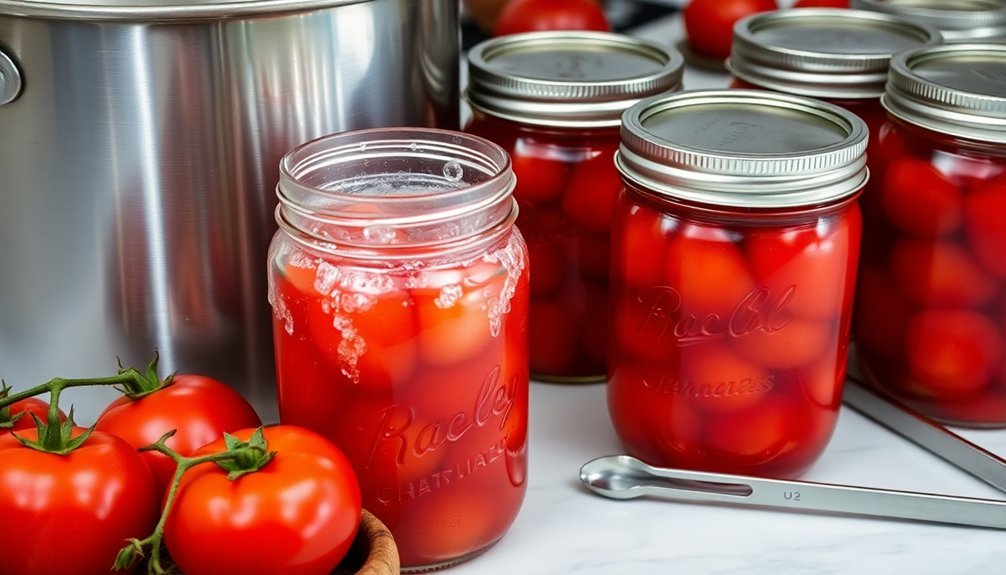
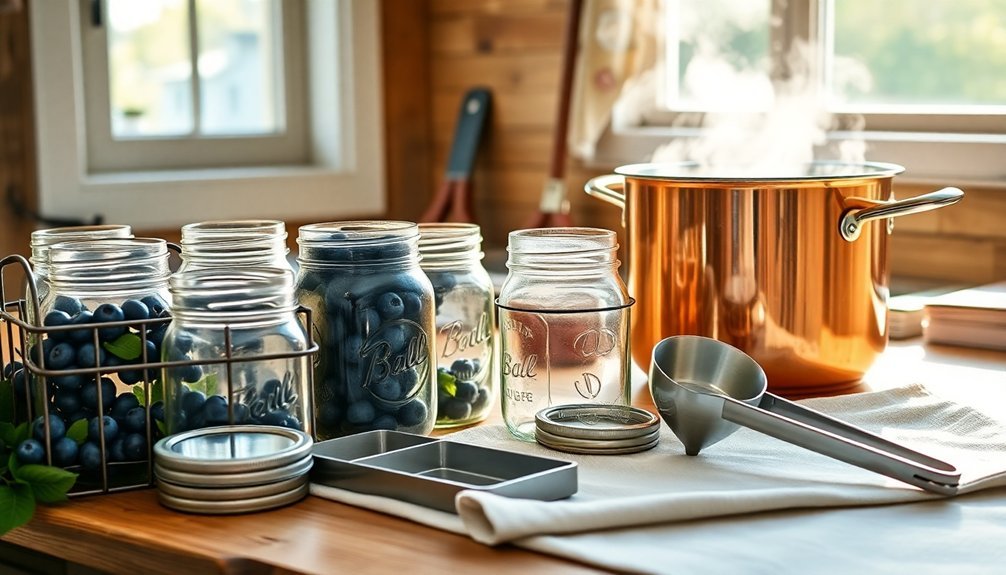
Leave a Reply